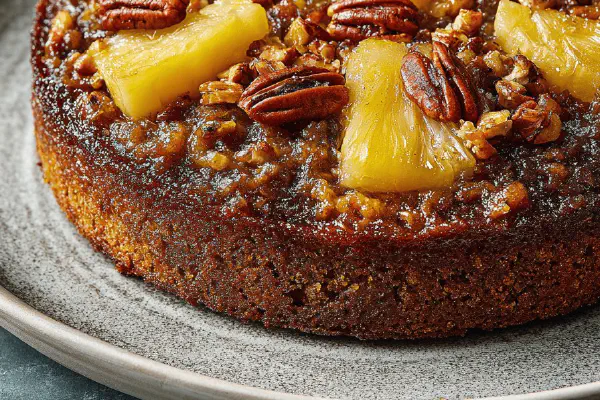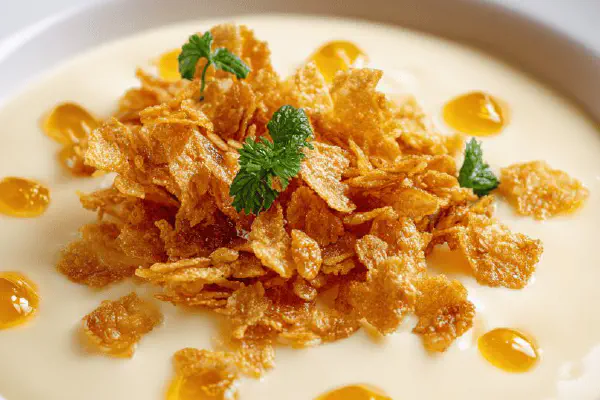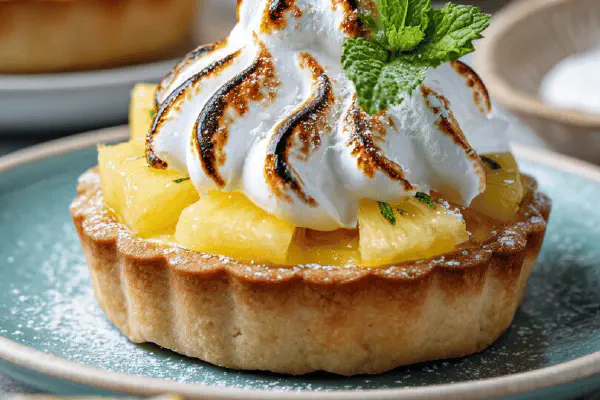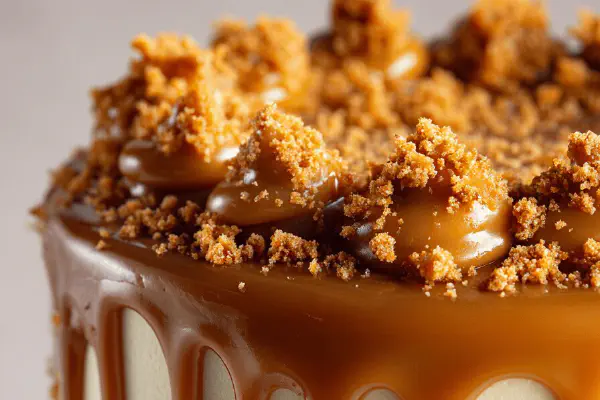Upside-Down Banana Cake

By Emma
Certified Culinary Professional
Ingredients
- 200 ml (3/4 cup plus 2 tbsp) unsalted butter, softened
- 200 ml (3/4 cup plus 2 tbsp) light brown sugar
- 3 ripe bananas, mashed
- 125 ml (1/2 cup) pineapple chunks, drained
- 75 ml (1/3 cup) pecans, coarsely chopped
- 2 eggs
- 10 ml (2 tsp) almond extract
- 125 ml (1/2 cup) whole milk
- 280 ml (1 1/4 cups) granulated sugar
- 360 ml (1 1/2 cups) all-purpose flour
- 8 ml (1 1/2 tsp) baking powder
About the ingredients
Method
- 1. Set oven to 185 °C (365 °F). Get sturdy 8 tube pan ready. No non-stick layer here — butter base crucial.
- 2. Beat half softened butter with brown sugar in bowl until creamy, grainy sheen visible, not melted. Press evenly into pan bottom. Now, pile pineapple chunks as base layer, scatter pecans on top. The fruit will bubble and add contrast to dense cake.
- 3. Mix eggs, almond extract, and milk in separate bowl. Grab wooden spoon or mixer; eggs loosen batter, milk hydrates flour, almond heightens fruit notes.
- 4. In another vessel, whip remaining butter with granulated sugar, creamy but hold air. Stir in banana purée, add dry flour and baking powder alternated with milk-egg mix. Avoid over-mixing — tender crumb collapses; stop when just combined but no lumps.
- 5. Pour batter over fruit and nuts base, smooth gently, not flattening fruit. Look at texture — thick but pourable, glossy sheen says come on, bake me!
- 6. Slide pan mid-oven. Around 50 minutes, start poke test: wooden skewer poked in middle emerges mostly clean, doughy crumbs cling but no raw batter. Edges darken caramel color, smell rich, almost toasted. No gummy spots on sides.
- 7. Leave cake in pan 10-15 minutes—warm but not hot. Run thin spatula under edges carefully, flip onto plate with confidence. Fruit topping should glisten like jewels, sticky crust intact. If fruit sticks, gentle knife help necessary.
- 8. Cool further before slicing; flavors meld, aromas deepen. Airtight storage or wrapped to keep moist for days.
- 9. For extras, addition of cinnamon or sprinkle coarse sugar atop before baking brings crunch; swap nuts seasonally — toasted hazelnuts also win.
- 10. Common traps? Too liquid batter ruins crust; cold butter means lumps; overbaking dries crumb; be patient with flipping, it’s worth a slight fumble.
Cooking tips
Chef's notes
- 💡 Butter needs to be softened but not melted—too warm ruins aeration, cooler holds shape when creamed with sugar. Press brown sugar and butter firmly for base. If fruit moist, drain pineapple very well or cake edges turn soggy. Timing of bake critical; edges smell toasty, darker caramel tone shows crust forming but center still bouncy means done.
- 💡 Mix eggs, almond extract, milk separately—stops overmixing dry ingredients, keeps batter tender. Fold banana in late, gentle strokes, avoids crushing air pockets formed after creaming. Alternating dry flour-powder with wet mix best; add slowly, stop once lumps gone or crumb turns tough. Poke test essential—wooden skewer should come mostly clean with just moist crumbs.
- 💡 Use pineapple chunks over cherries for acidity balance but drain! Nuts toasted beforehand deepen flavor, etc... don’t skip pecan swap- walnut bitterness creeps in unwanted. Brown sugar type impacts caramel flavor spectrum; dark sugar more intense, light sugar milder. Butter base replaces nonstick; coat pan thoroughly or peel fails after baking.
- 💡 Bake temp lower than many: 185 C keeps crust caramelizing slowly without burning. Too hot and crust burns yet inside undercooked. Let cake cool 10-15 minutes in pan before flipping; run spatula edges carefully—fruit topping fragile, sticky crust tears easily. Flip quick but steady; plate gripping crucial to avoid disaster.
- 💡 Extra sugar sprinkle or cinnamon optional tweaks—cinnamon adds warmth, sugar crunch on top contrasts sticky caramel. Keep batter thickness medium thick; too runny batters sink fruit layer, too dense stops rise. If batter slack, add one tablespoon flour last minute. Storage best airtight wrapped foil, keeps moist and aroma settled over days.
Common questions
Can I swap pecans for walnuts?
Yes but walnuts add slight bitterness—soak or toast first. Texture differs, softer bite. Pecans give buttery mellow feel. Nuts toasted or raw change crunch too.
How to tell when cake is baked?
Look for browned edges—deep caramel not burnt. Smell nutty toasted sugar. Skewer test key; crumbs moist but no raw batter. Cake springs back gently but not hard. Baking times vary oven to oven.
What if batter too runny?
Add dry flour spoonful by spoonful carefully. Bananas ripeness affects moisture; overripe breeds runny batter. Drain pineapple chunks well or crust soggy edges. Cold butter lumps batter; room temp soft use helps mix.
Best way to store leftovers?
Wrap warm cake in foil lightly or airtight container. Refrigerate or room temp, lasts few days. Cooling completely first prevents condensation soggy crust. Freeze slices wrapped tight; thaw slowly to keep texture.



